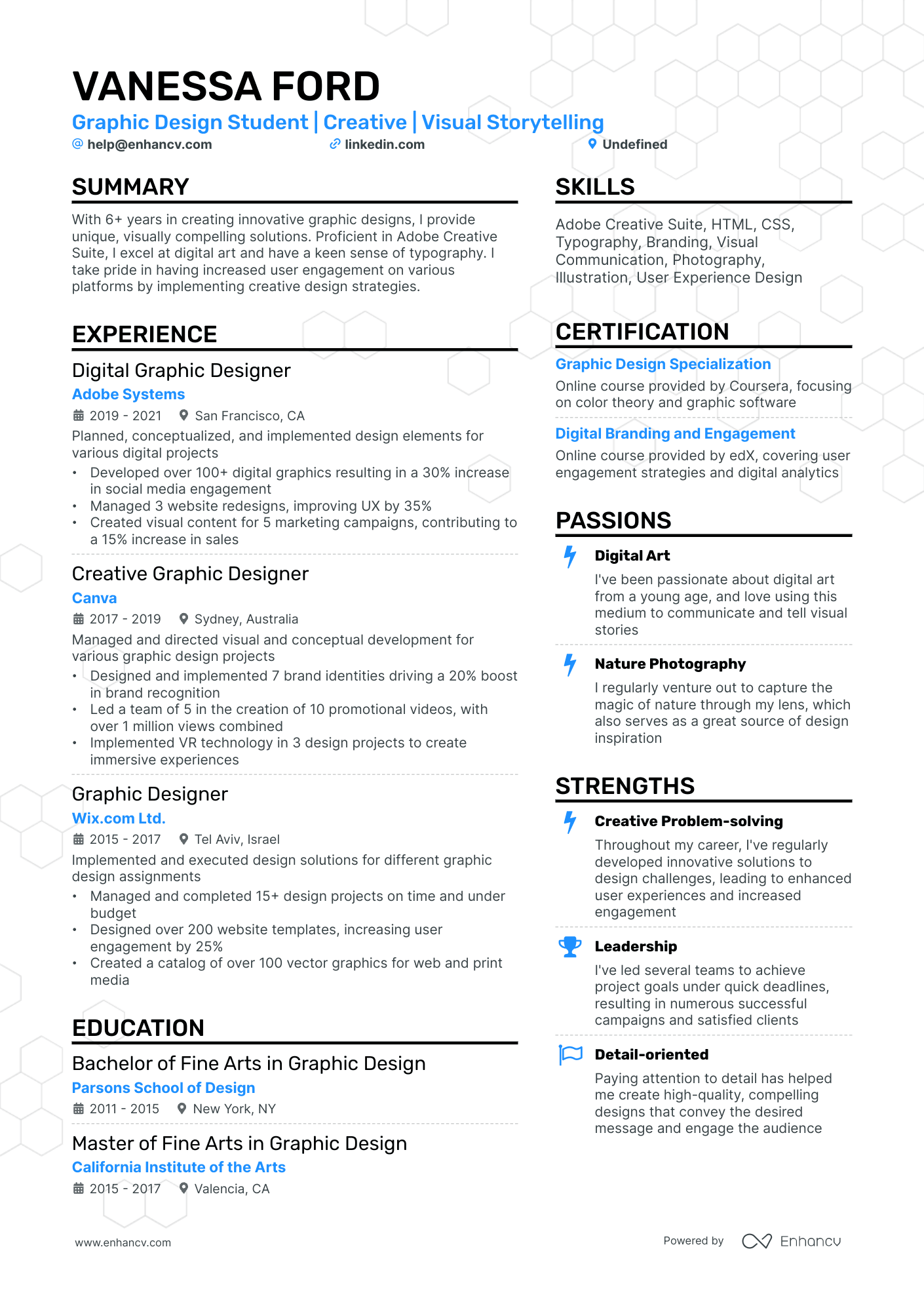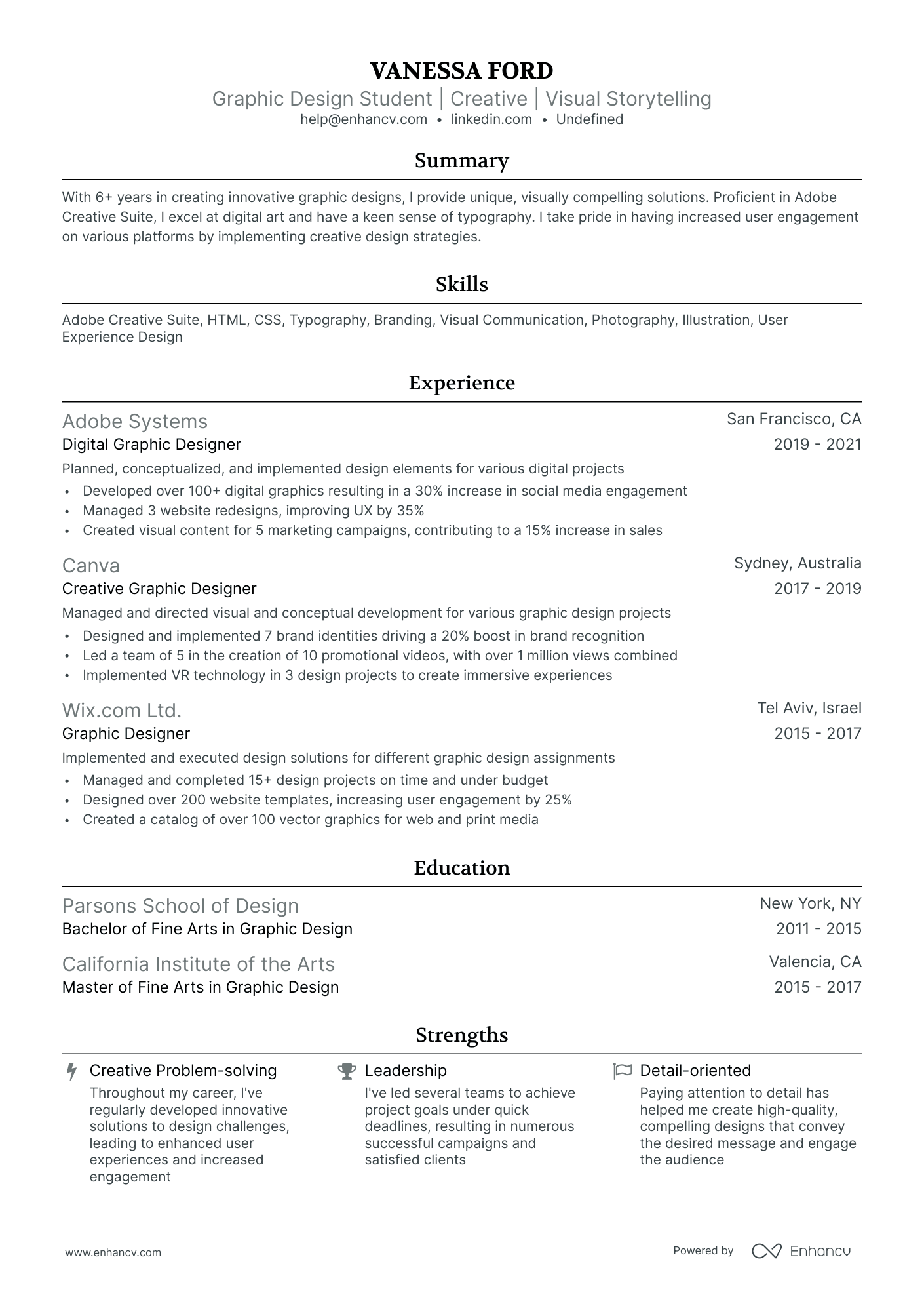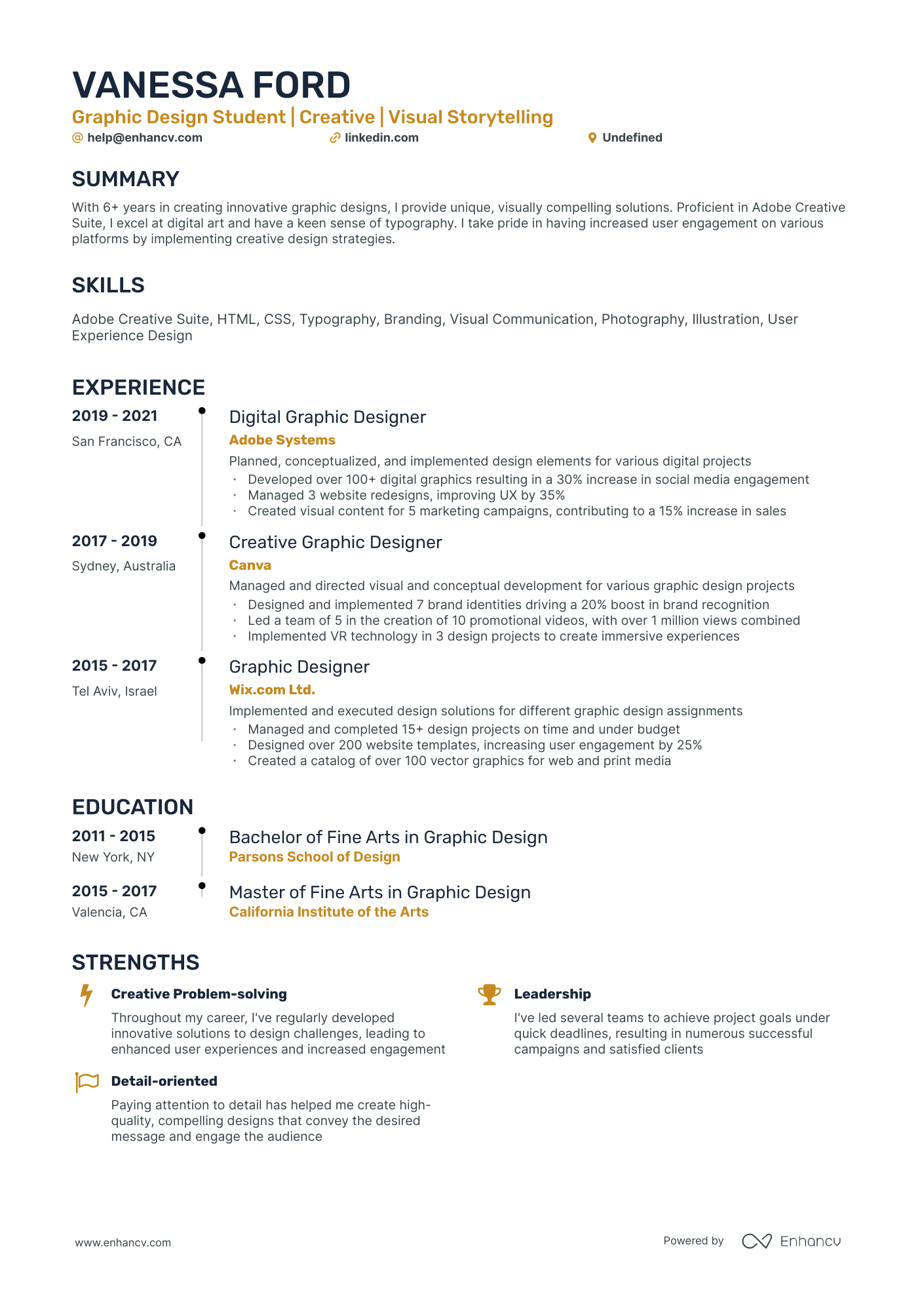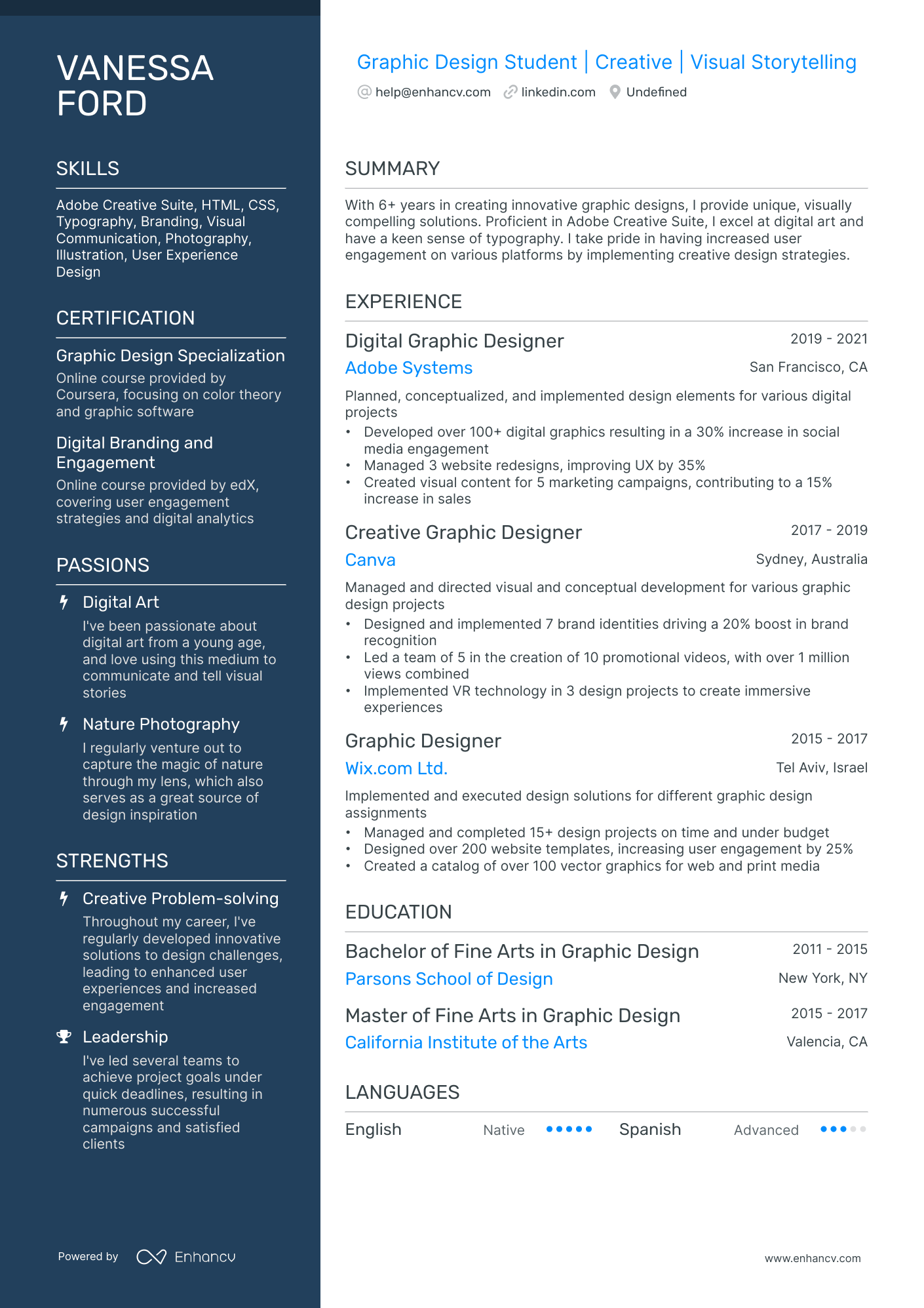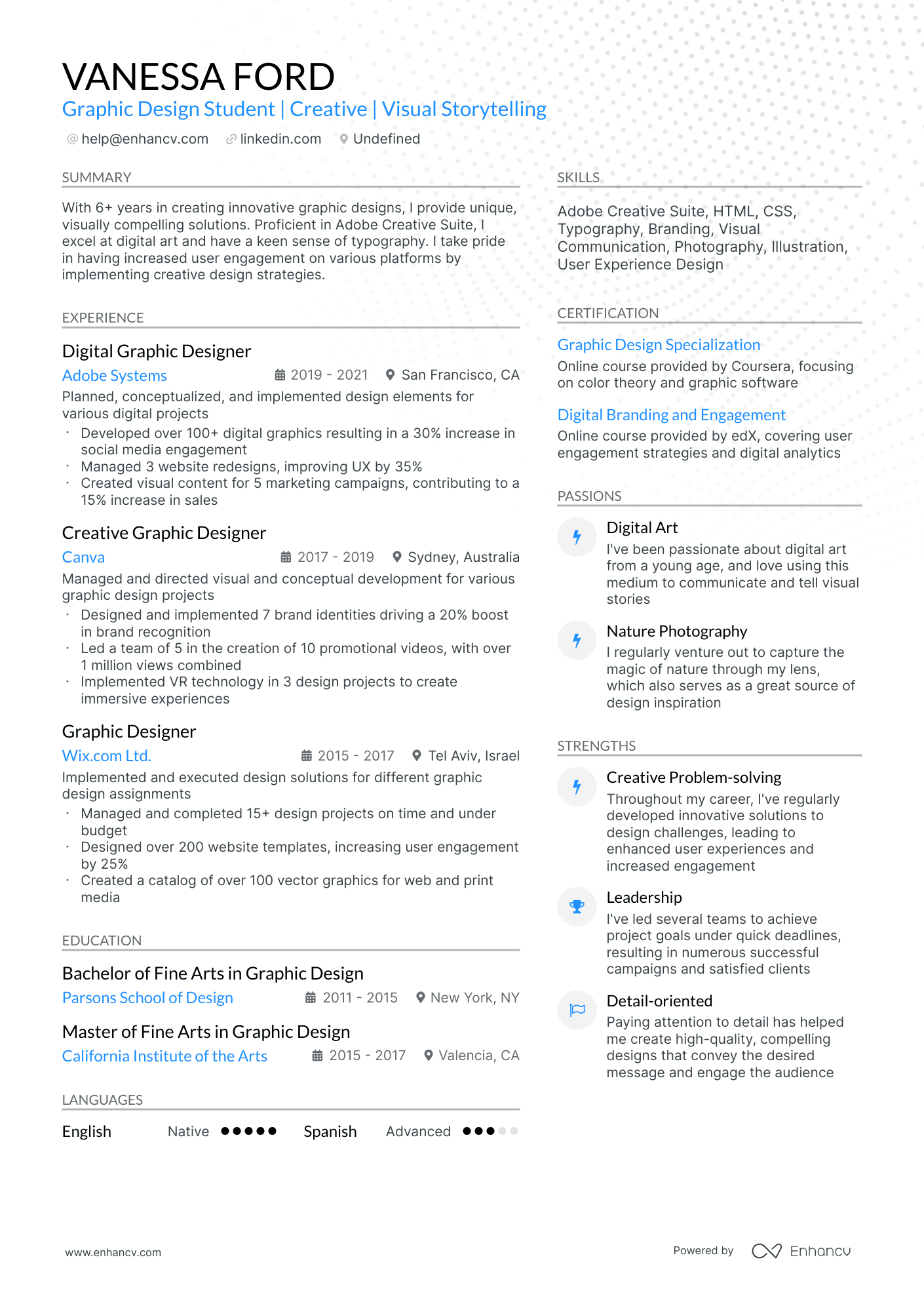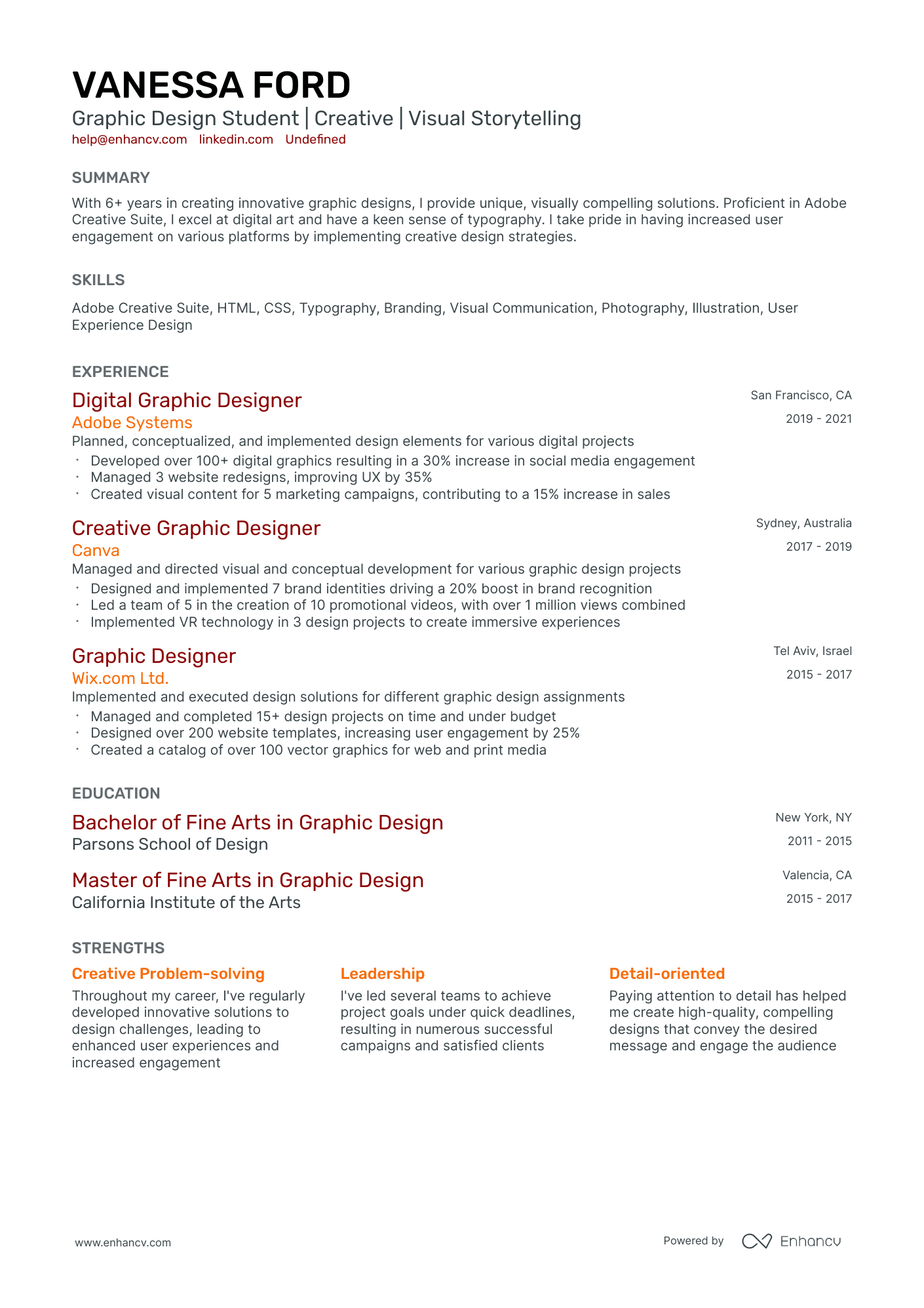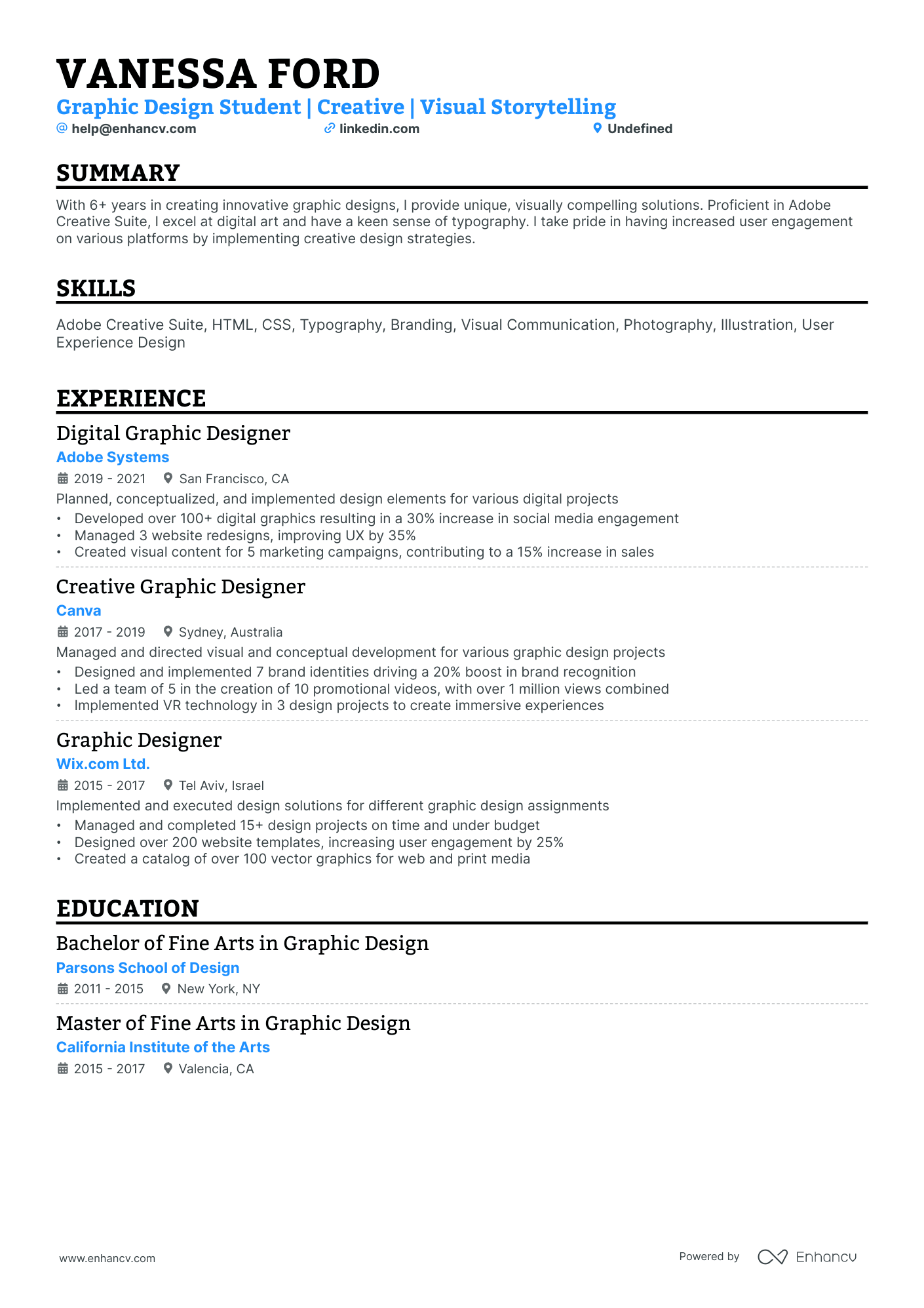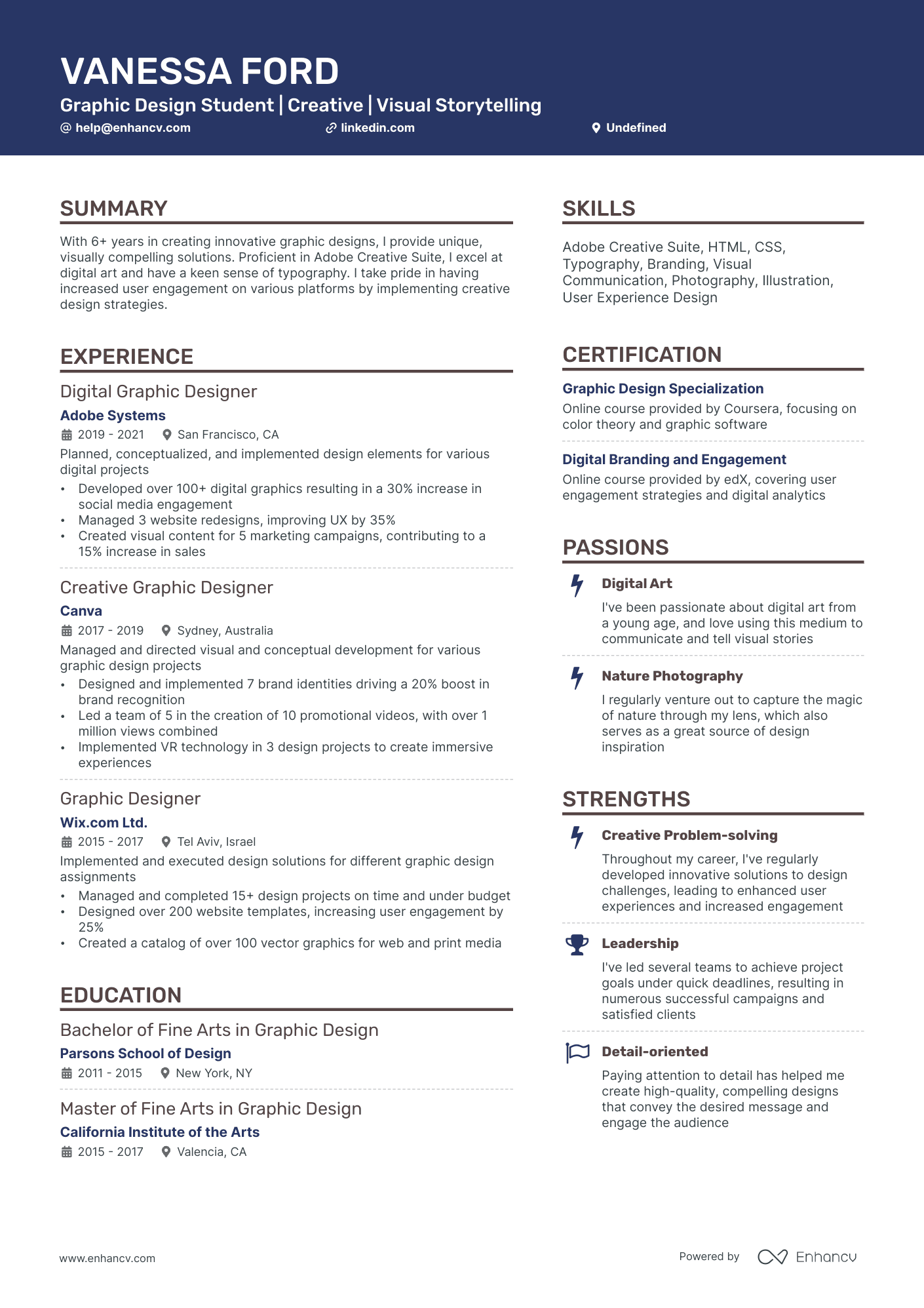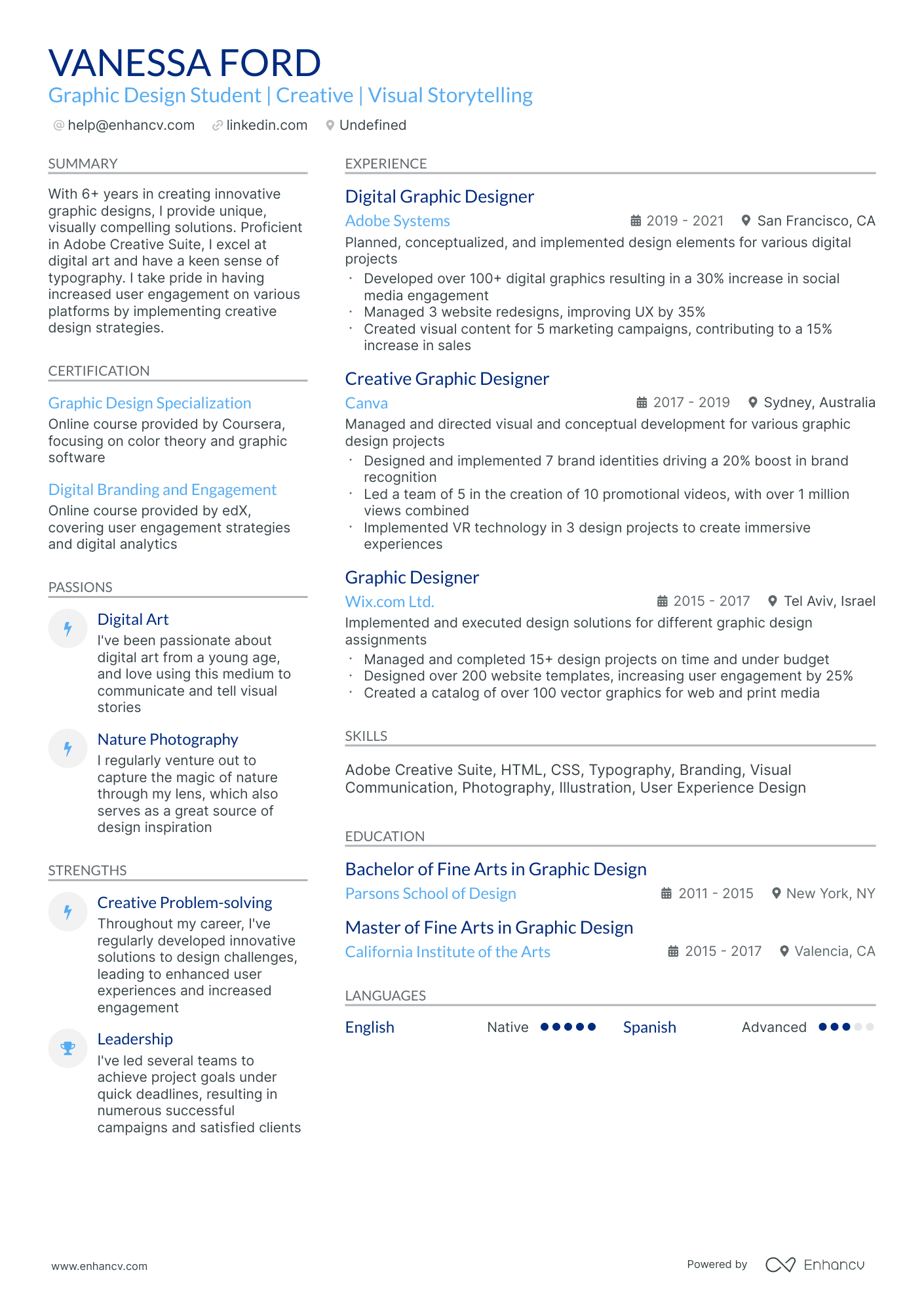A common resume challenge faced by graphic design students is showcasing their creative abilities and design portfolio effectively within the constraints of a traditional resume format. Our guide can assist in this by providing insights on how to integrate visual elements and project links strategically without overwhelming the reader, thus effectively communicating your design proficiency and versatility.
Dive into our concise guide to learn how to:
- Show your graphic design student career's brightest moments through your resume's summary, objective, and experience sections.
- Explore top-notch graphic design student resume examples to understand how to distinguish yourself from other candidates.
- Identify the most sought-after graphic design student skills and certifications in the industry.
- Design a structured yet unique resume layout.
Recommended reads:
Styling your graphic design student resume: layout and format
Pondering the ideal length for your graphic design student resume? Experts suggest keeping it between one and two pages. Opt for the two-page format if you boast over a decade of pertinent experience. Moreover, the resume format you choose is pivotal in showcasing your experience. Consider the:
- Reverse-chronological resume format to spotlight your career journey;
- Functional skill-based resume format if you're light on experience but want to emphasize skills;
- Hybrid resume format to provide recruiters a comprehensive view of both your experience and skills.
Here are some additional tips for your graphic design student resume layout:
- Keep your headline straightforward: mention the job you're targeting, a notable certification abbreviation, or your professional specialty;
- Always customize your graphic design student resume for the specific role, aligning job requirements with your experience in various resume sections;
- After finalizing your resume, save it as a PDF (unless instructed otherwise) to maintain its readability and layout consistency.
Each market has its own resume standards – a Canadian resume layout may differ, for example.
Upload your resume
Drop your resume here or choose a file. PDF & DOCX only. Max 2MB file size.
Pro tip
Choose a legible, professional font for your graphic design student resume, such as Arial or Calibri.
The five (plus) definite sections your resume for a truck dispatcher job should include are:
- Header with your headline, contact details, and/or a preview of your work
- Summary (or objective) to pinpoint how your success aligns with the role
- Experience with bullets of your most relevant achievements in the field
- Skills to integrate vital job requirements (both technical and personal)
- Your further dedication to the field, showcased via relevant higher education and/or certifications
What recruiters want to see on your resume:
- Proficiency in Design Software: Demonstrating skills in software like Adobe Photoshop, Illustrator, InDesign, and other relevant design tools.
- Strong Portfolio: Showcase of a robust portfolio that illustrates your creativity, style, and proficiency in various design disciplines.
- Understanding of Design Principles: Deep understanding of fundamental visual design disciplines such as typography, layout, colour theory, and branding.
- Creativity and Innovation: Ability to produce original, creative design solutions that effectively communicate brand messages.
- Attention to Details: Precision and attention to detail in all aspects of design work from conception to final output.
Recommended reads:
Decoding the graphic design student resume experience section
Once you've settled on your resume's format, the next step is detailing your professional journey.
Many graphic design student professionals grapple with this section, especially when balancing between extensive or limited experience. Here's a roadmap to navigate this:
- Limit bullet points under each job role to six, focusing on high-impact contributions.
- Highlight achievements that resonate with the job's requirements, rather than just listing duties.
- Detail any on-the-job certifications or skills acquired and their relevance to your growth.
- Choose impactful verbs for each bullet, avoiding overused terms like "managed".
- Infuse relevant keywords from the job posting, especially in the context of accomplishments.
For more insights, explore these curated examples from seasoned graphic design student professionals:
- Collaborated with a team of designers to create engaging visual content for social media platforms resulting in a 40% increase in user engagement.
- Executed various design projects including logo designs, brochures, and website layouts, adhering to brand guidelines and meeting client expectations.
- Implemented innovative design concepts and explored new techniques to enhance user experience.
- Assisted senior designers in managing multiple projects simultaneously, ensuring timely delivery and client satisfaction.
- Participated in brainstorming sessions and provided creative input for marketing campaigns.
- Conceptualized and designed print advertisements for prominent clients resulting in a 20% increase in sales.
- Collaborated with copywriters to develop visually compelling layouts that effectively communicated key messages.
- Utilized Adobe Creative Suite to create high-quality designs, including posters, banners, and promotional materials.
- Managed multiple projects simultaneously, prioritizing tasks and meeting strict deadlines.
- Conducted market research to identify current design trends and incorporate them into the creative process.
- Designed and implemented user-friendly interfaces for mobile applications resulting in a 25% improvement in user retention.
- Created wireframes and prototypes to visualize design concepts and collaborated with the development team for implementation.
- Developed iconography and visual assets to enhance the overall user experience.
- Conducted usability testing and incorporated user feedback into iterative design updates.
- Worked closely with stakeholders to understand project requirements and deliver designs that aligned with business goals.
- Led a team of designers in creating comprehensive branding packages for new clients resulting in a 30% increase in customer acquisition.
- Developed visually appealing website layouts using HTML, CSS, and JavaScript, ensuring cross-browser compatibility and responsive design.
- Collaborated with marketing managers to develop creative strategies and deliver consistent brand messaging across various platforms.
- Created engaging infographics and data visualizations to communicate complex information effectively.
- Implemented user research methodologies and conducted user interviews to inform design decisions.
- Designed eye-catching packaging for new product launches resulting in a 25% increase in sales.
- Collaborated with the marketing team to create compelling visuals for social media campaigns and digital advertisements.
- Utilized Adobe Illustrator and Photoshop to create vector illustrations and manipulate images.
- Contributed to the development of style guides and brand identity for multiple product lines.
- Coordinated with external print vendors to ensure accurate production and timely delivery of packaging materials.
- Developed creative concepts and executed designs for marketing collateral, including brochures, flyers, and promotional materials.
- Collaborated with cross-functional teams to ensure brand consistency across all visual elements.
- Performed photo retouching and manipulation to enhance image quality and optimize visual impact.
- Managed multiple design projects concurrently, maintaining a high level of productivity and meeting project deadlines.
- Stayed up-to-date with industry trends and emerging design technologies to continuously improve design skills.
- Created visually compelling illustrations used in children's book publications resulting in positive feedback from readers and publishers.
- Designed book covers and layouts, incorporating typography and imagery to effectively convey the book's theme.
- Collaborated with authors and editors to understand their vision and translate it into captivating visual elements.
- Ensured adherence to print production standards and prepared files for printing.
- Conducted market research to identify design trends in the children's book industry.
- Created engaging visual content for social media platforms resulting in a 50% increase in followers and user interactions.
- Produced animated videos and motion graphics to support marketing campaigns and product launches.
- Collaborated with marketing managers to develop creative strategies and deliver consistent brand messaging.
- Utilized Adobe After Effects and Premiere Pro to edit and enhance video content.
- Managed multiple projects concurrently, ensuring high-quality deliverables and meeting project deadlines.
- Created visually appealing website designs using responsive design principles and best UX practices resulting in increased user engagement.
- Collaborated with developers to implement designs using HTML, CSS, and JavaScript frameworks.
- Optimized website performance and user experience through thoughtful design decisions.
- Conducted user testing and gathered feedback to iterate and improve the user interface.
- Participated in cross-functional team meetings to align design objectives with business goals.
- Designed visually stunning event posters and promotional materials for concerts and festivals resulting in increased ticket sales.
- Collaborated with event organizers to capture the essence of the event and translate it into compelling visual designs.
- Utilized typography, color theory, and layout techniques to create impactful designs.
- Prepared files for print production and ensured accuracy during the printing process.
- Implemented design changes based on feedback from clients and stakeholders.
Quantifying impact on your resume
<ul>
Addressing a lack of relevant graphic design student experience
Even if you lack direct graphic design student experience, you can still craft a compelling resume. Here's how:
- Highlight projects or publications that demonstrate your relevant skills or knowledge.
- Emphasize transferable skills, showcasing your adaptability and eagerness to learn.
- In your objective, outline your career aspirations and how they align with the company's goals.
- Consider a functional or hybrid resume format, focusing on skills over chronological experience.
Recommended reads:
Pro tip
The wording of your experience items should be with active, power verbs, instead of adjectives. Always be specific about each item you detail, and never overuse vague buzzwords. You weren't just "organized", but rather "Enhanced internal work processes to optimize operational management by 65%".
Spotlighting your graphic design student hard and soft skills
Hard skills denote your technological proficiency and expertise in specific tools or software. These skills are often validated through certifications and hands-on experience.
Soft skills, on the other hand, reflect your interpersonal abilities and how you navigate workplace dynamics. These skills are cultivated over a lifetime and can be more nuanced.
Why the emphasis on both? Hard skills demonstrate your technical competence and reduce training needs. Soft skills suggest adaptability and cultural fit.
To optimize your skills section:
- Forego basic skills like "Excel" in favor of more specific proficiencies like "Excel Macros".
- Highlight core values and work ethics as soft skills, indicating what you prioritize in a professional setting.
- If relevant, create a distinct section for language proficiencies.
- Balance hard and soft skills by crafting a strengths or achievements section, illustrating outcomes achieved through both skill sets.
To assist you, we've curated a list of skills highly sought after by recruiters. Ensure you integrate those that resonate with your expertise and the prospective employer's needs:
Top skills for your graphic design student resume:
Adobe Photoshop
Adobe Illustrator
Adobe InDesign
CorelDRAW
Sketch
Figma
Adobe XD
InVision
HTML/CSS
Typography
Creativity
Attention to Detail
Time Management
Communication
Collaboration
Problem Solving
Adaptability
Critical Thinking
Open-mindedness
Self-motivation
Pro tip
Double-check the spelling of all skills and tools on your resume. Remember, software like the Applicant Tracker System (ATS) scans for these details.
Highlighting certifications and education on your graphic design student resume
Your academic achievements, including certifications and degrees, bolster your application. They showcase your skills and commitment to the field.
To effectively present these on your resume:
- Highlight significant academic achievements or recognitions relevant to the role.
- Be selective; prioritize the most relevant and impressive certifications.
- Include essential details: certificate/degree name, institution, graduation dates, and license numbers (if applicable).
- Present your academic background in reverse chronological order, emphasizing the most recent and relevant qualifications.
For further guidance, explore popular industry certifications.
Best certifications to list on your resume
Pro tip
List your degrees in reverse order, starting with the newest. A recent PhD or unique field could set you apart.
Recommended reads:
best practices for your graphic design student resume summary or objective
How do you know if you should include a resume summary or a resume objective?
- Resume summaries are ideal for graphic design student professionals with more experience, who'd like to give a quick glimpse of their biggest career achievements in the top one-third of their resumes.
- On the other hand, resume objectives serve as a road map to the applicant's aspirations. Candidates use the objective as the North Star of their career (or, how they see themselves in the role in the next few years).
Both could be the perfect fit for your graphic design student resume, depending on your experience.
Here's how candidates for the graphic design student job structure their summaries and objectives.
Resume summary and objective examples for a graphic design student resume
Optimize your resume summary and objective for ATS
Drop your resume here or choose a file.
PDF & DOCX only. Max 2MB file size.
Enhancing your graphic design student resume with additional sections
Make your graphic design student resume truly distinctive by adding supplementary sections that showcase:
- Awards that underscore your industry recognition.
- Projects that bolster your application's relevance.
- Hobbies, if they can further your candidacy by revealing facets of your personality.
- Community involvement to highlight causes you champion.
Key takeaways
- Keep your graphic design student resume clear and organized with key sections.
- Only include relevant details. Space is limited.
- Support your achievements with both hard and soft skills.
- Detail your experience, focusing on your industry expertise.
- Highlight the most relevant certifications to show your dedication to the field.

